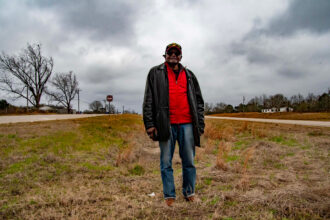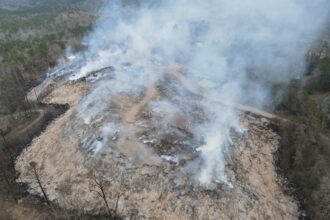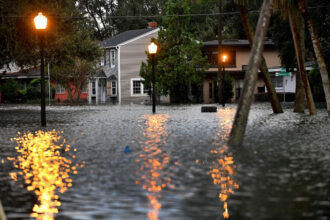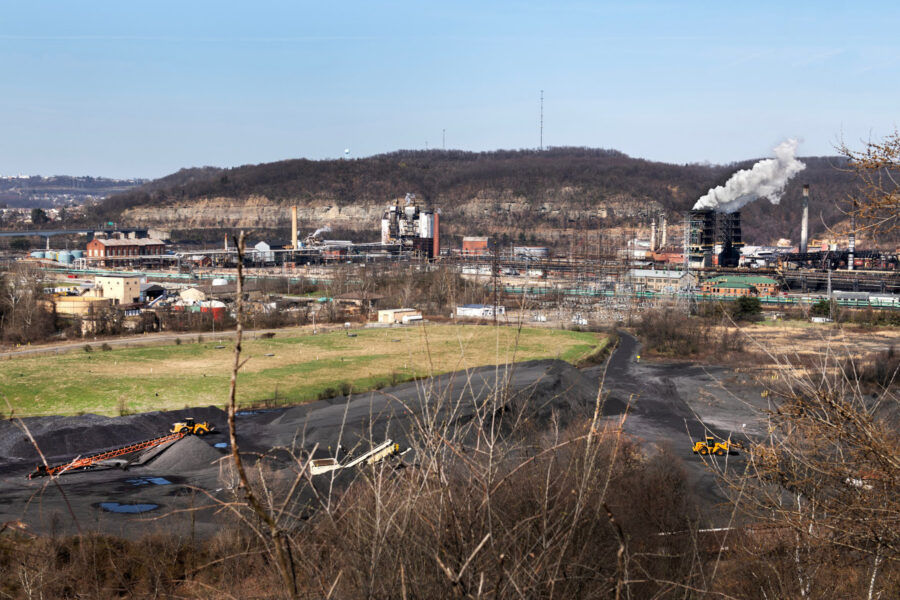BIRMINGHAM, Ala.—As Kacey Brantley entered her neighborhood earlier this month, she thought the car in front of her was having some kind of mechanical issue. A pungent smell, like gas and burnt plastic, filled her lungs.
“I started gagging it made me so nauseous,” she said.
It wasn’t just the car in front of her. The whole neighborhood smelled. The smell, Brantley would later find out, came from a gasoline spill caused by a tanker accident a little over a mile from her home.
In the early morning hours of March 2, an 18-wheeler carrying 7,500 gallons of gasoline collided with a guardrail on Interstate 59 in northeast Birmingham, causing it to flip on its side, according to emergency management officials. An SUV soon collided with the crashed truck, officials said, compounding the damage. First responders extracted the drivers of both vehicles and transported them to a local hospital for treatment.
Emergency management officials, in response to questions from Inside Climate News, estimated that, as a result of the crash, “approximately 2100 gallons of gasoline and diesel spilled onto the grassy embankment of the interstate.” A “significant amount of fuel” flowed into a drainage outlet and eventually spilled into nearby Village Creek, “resulting in a significant fish kill in the area.”
Local, state and federal officials responded to the site for an immediate cleanup, but local environmentalists have said more needs to be done to ensure a thorough cleanup is undertaken and that those responsible for the crash and resulting gas spill are held accountable.
Kenan Advantage Group (KAG), the company that state officials said operated the truck involved in the accident, has a lengthy record of safety violations, according to federal records reviewed by Inside Climate News. The company did not respond to repeated requests for comment.
Kacey Brantley knew something was up.
Like thousands of others, she’d received an emergency notification on her phone that a nearby section of I-59, an interstate that runs through Birmingham, was completely shut down. The electronic notification didn’t mention the fuel that would soon reach Village Creek, which runs along Brantley’s backyard.
After running errands with her mother, Brantley, 38, returned to her neighborhood and was overwhelmed by the smell. Much of the media coverage around the spill focused solely on the traffic impacts, leaving Brantley and others confused by the stench.
The crash that led to the gasoline spill occurred around 2:45 a.m. on Interstate 59 North near the Roebuck exit in Birmingham, the local fire and rescue service confirmed. The KAG tractor-trailer involved, authorities said, struck a guardrail and flipped on its side before being struck by another vehicle. The collisions caused a rupture in the trailer, spilling “approximately 2100 gallons of gasoline/diesel,” according to emergency officials.
After leaking from the tanker, the fuel flowed off the interstate into nearby drainage infrastructure, eventually meandering its way through a residential neighborhood to Village Creek, which flows through Birmingham and on toward the Locust Fork of the Black Warrior River.

Nelson Brooke with Black Warrior Riverkeeper arrived near the scene of the spill early Saturday morning just hours after the spill. He said he was underwhelmed by the response to what he sees as an environmental disaster.
Local firefighters and police as well as state and federal environmental workers responded to the scene, according to emergency officials.
Brooke said it was unclear to him who was in charge, but that he told those at the site that best cleanup practices would include placing aeration tubes in Village Creek that would help diffuse the pollutants in the water column.
“That just wasn’t on their radar nor was it something that they seemed to have any urgency to get in place,” he said.
A spokesperson for the Alabama Department of Environmental Management said that the agency is monitoring the progress of remediation efforts, which are being carried out in large part by a contractor. Those efforts have included the placement and replacement of a boom, meant to limit fuel contamination, and the use of a vacuum truck to remove pockets of petroleum and petroleum-impacted water. Impacted soils will also be collected and removed from the site, the spokesperson said.
A spokesperson for the EPA said that the agency responded to the spill in an oversight capacity only, monitoring the state’s mitigation efforts.
Brantley said officials never notified her or her neighbors about the impacts of the spill. She said she and her mother reached out to various entities to find out more but were only told that if an evacuation was necessary, someone would come to their door.
“The smell caused me headaches for two days,” Brantley said. “I am still getting headaches at night.”
Brantley’s primary care physician told her that if she can leave her home, she should. But Brantley said it isn’t so simple financially or logistically to round up her pets and find somewhere else to stay, even temporarily. So she’s done what she can to limit her exposure to the air, particularly in the backyard near Village Creek. She’s made sure all her windows are shut tight. She’s put wet towels under the bottoms of her doors.
Exposure to gasoline vapors, even for a short period, can cause health problems like nose and throat irritation, headaches, dizziness, nausea, vomiting, confusion and breathing difficulties, according to federal and state health authorities.

Brantley said that government entities and media outlets should have done a better job of notifying residents near and downstream of the spill site about potential health and safety risks.
“The only people I heard say to stay away from it were the riverkeepers,” Brantley said. “All the news was focused on the traffic, and that’s frustrating. This is my backyard.”
KAG, which bills itself as “the largest tank truck transporter and logistics provider” in North America, has been involved in previous gasoline spills and has been repeatedly cited for safety violations, including violations related to the transport of hazardous materials.
In the last two years, KAG trucks have been involved in 62 crashes, according to federal safety records, including crashes that caused injuries in Ohio, Florida, Texas, Louisiana and Georgia.
Records from the Federal Motor Carrier Safety Administration also document 995 violations of safety standards by company drivers, ranging in seriousness from parking improperly to driving while in possession of drugs. These citations have also included violations of regulations around the transport of hazardous materials, including the “improper release” of hazardous cargo.
In 2021, for example, the company paid the federal government $33,190 to settle an enforcement case against it related to the transport of hazardous materials, records show.
State records and local press accounts also reveal that KAG trucks have often been involved in fuel spills around the country.
In 2015, for example, a KAG truck collided with a section of an interstate bridge in Washington, spilling over 3,500 gallons of fuel, contaminating soil and groundwater. Nearly two years after the spill, state environmental officials notified KAG that it was potentially liable for the site cleanup, a status the company accepted. A state-supervised cleanup proceeded but did not formally end until April 2020.
Brooke said he hopes that those responsible for the spill in Birmingham will be held accountable. He’s worried that, as in the past, state environmental officials will simply slap the company on the wrist and not force any changes that could prevent a spill of this magnitude from happening again in the future.
He also hopes that instead of simply having to pay a fine to ADEM, those responsible for the spill may contribute to improving conditions at Village Creek.
“Let’s put some money in the place harmed,” Brooke said. “That’s the outcome we would like to see.”
But Brooke says state and local officials already could have done more to mitigate the impacts of the fuel spill. The spill has already led to a significant fish kill, with thousands of fish estimated to be dead after being exposed to pollutants. State officials are currently formally assessing the scope of those deaths.
This story is funded by readers like you.
Our nonprofit newsroom provides award-winning climate coverage free of charge and advertising. We rely on donations from readers like you to keep going. Please donate now to support our work.
Donate NowThen there are the human impacts.
“Clearly more could have been done much earlier on to keep this from getting so much further down Village Creek,” Brooke said. “There are thousands of homes and multiple communities all along the path of Village Creek where the spill impacted the creek. That’s a lot of people being exposed to this gasoline stench. It’s dangerous to be inhaling that, especially over an extended period of time.”
Brooke encourages those who live on or near the stream to stay away from the water, particularly if you smell gas or any other pungent odor.
“And if you experience headache or any sort of physical complication from inhaling the smell, seek medical attention,” he said.













